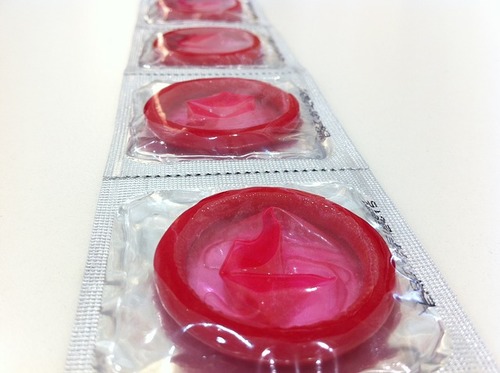Short answer
Unless you have an allergy to latex or your partner (female) is sensitive to latex or spermicide, you and your partner will most likely be fine. While it does not always prevent STD transmission and pregnancy, a condom is certainly more effective than no condom.
'N' stands for neutral. Things placed into this category are (a) neither good nor bad for you, or (b) lack the necessary evidence to reach any conclusions.
View Full Grading System
Category 'A'
Very healthy and numerous health benefits. Side effects are rare. Things rated an 'A+' are typically necessary for survival (for example, water).
Very healthy and numerous health benefits. A few harmful qualities may be associated, but only under certain circumstances such as an allergic reaction.
Very healthy and numerous health benefits. Harmful qualities may be associated, but aren't usually serious.
It is important to note that even the best things in life can become bad in immoderate amounts. So, although something may be rated an 'A+', overconsumption/overdoing can bring unwanted effects.
Category 'B'
Very beneficial to your health. Things rated a 'B+' may have a few harmful qualities to pay attention to.
Overall beneficial to your health. Things rated a 'B' may have some harmful qualities to pay attention to.
More beneficial to your health than not. However, harmful qualities are most likely associated and shouldn't be overlooked.
The main difference between category 'A' and category 'B' is the harmful qualities typically present in 'B' items. Serious side effects are usually uncommon, but are still possible and should be taken note of.
Category 'C'
Both beneficial and harmful qualities associated. Things rated a 'C+' are typically a bit more on the beneficial side. Still, moderation is important.
A fairly even ratio of beneficial and harmful qualities. Moderation is important. Very general topics that can lean towards both sides of the spectrum will be placed here as well. Rice, for example, can be good or bad depending on the type.
More harmful than beneficial. Side effects are common, especially when consumed/done excessively. Moderation is very important.
Category 'C' usually denotes to both good and bad qualities. When it comes to this category, it is important to keep this word in mind: moderation.
Category 'D'
Harmful to your health. Although benefits may be associated, the bad most likely outweighs the good. Moderation is very important.
Harmful to your health. A few benefits may be associated, but the bad outweighs the good. Moderation is extremely important.
Harmful to your health. Very few, if any, benefits are present. Things in this category should be avoided as much as possible.
Category 'D' is typically for things that are more harmful than beneficial. While consuming/doing something unhealthy once in a blue moon shouldn't hurt, we definitely recommend eliminating 'D' items as a regular part of your routine/diet.
Category 'F'
Category 'F' is for things that fail to bring anything beneficial to the table, and are very harmful to your health. We recommend completely avoiding anything in this category. Long-term side effects of 'F' items are usually very serious.
Category 'N'
'N' stands for neutral. Things placed into this category are generally (a) neither good nor bad for you, or (b) lack the necessary evidence to reach any conclusions.
Long answer
Condoms come in all shapes and sizes - and when it comes to condoms, size does matter. The reason for this is that if a condom is too small, it is more likely to break, while as a condom that is too loose is liable to slip off. Condoms are used for two reasons - to prevent pregnancy and to prevent the transmission of an STD. While they typically do their job very well, it is important to note that condoms are not 100% effective in either case (many studies show condom effectiveness to be 97-98%)
Other than breaking or slipping off, there are other concerns regarding condoms. Some condoms are lubricated with a spermicide, or nonoxynol-9, which can irritate the vagina and rectum. Also, latex condoms can trigger an allergic reaction, with symptoms ranging from mild (a runny nose) to serious (rash, hives), all the way to extreme (airway constriction).
Spermicidal condoms should be avoided not just for the aforementioned reason, but also that they have a shorter shelf life, are more expensive, and have not been found to be more effective than non-spermicidal condoms.
Other downsides include lowered sensation and the fact that stopping to put on a condom does much to ruin the excitement of sex had at the spur of the moment.
Unless you are allergic to latex, if you use a non-spermicidal condom, you will most likely be fine - especially if you and your partner are STD-free. While pregnancy is a possibility, condoms (when the right size) do provide a high rate of protection. However, if you need a 100% foolproof way to avoid pregnancy or catching an STD, your only option is abstinence.
Possible short-term side effects
- decreased pleasure
-
genital irritation
-
latex allergic reaction
Ingredients to be aware of
Benefits
- helps prevent unwanted pregnancy
-
helps prevent std transmission
Healthier alternatives
Please turn your Ad Blocker off to see this content. Thank you!
Thank you for your feedback!
Written by Jeff Volling
Published on: 12-28-2015
Last updated: 12-10-2016
Thank you for your feedback!
Written by Jeff Volling
Published on: 12-28-2015
Last updated: 12-10-2016

 Approved by
Approved by 















